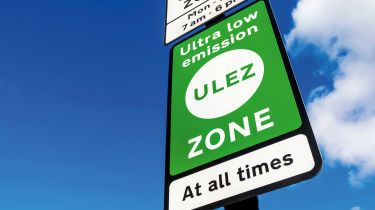ULEZ compliant vans: rules and charges explained
Driving your van in London’s Ultra Low Emissions Zone could be very expensive if it doesn’t meet the latest emissions standards. We explain the ULEZ rules and charges...

In 2019, the Ultra Low Emission Zone (ULEZ) was introduced in London in a bid to improve air quality. It started off covering the same area as the Congestion Charge Zone, and vehicles falling short of certain emissions standards had to pay an additional fee in order to enter it. From October 2021, the zone was enlarged to take-in all of London within the North and South Circular ring roads. Then, in August 2023, the ULEZ was extended further to include all London boroughs - almost everything within the M25 motorway.
The ULEZ is in force 24 hours a day, every day of the year with the exception of Christmas Day. If your vehicle does not meet the ULEZ emissions criteria, you have to pay to enter or drive within the zone.
The Ultra Low Emission Zone is different to the Low Emission Zone (LEZ). Both now cover the same area, but the LEZ affects HGVs and specialist vehicles weighing more than 3.5 tonnes.
The ULEZ should also not be confused with London’s Congestion Charge, which applies a £15 fee to all vehicles entering its specific area in central London.
ULEZ compliant vans: what are the emission standards?
Emissions standards for passenger cars were introduced across Europe for the first time in 1970, setting limits on the amount of carbon monoxide, nitrogen oxide, hydrocarbon and particulate matter each vehicle could emit per kilometre driven. The first update - known as Euro 1 - arrived in 1992; today, vehicles must meet the current Euro 6 standards. A new Euro 7 standard is set to come into force from July 2025 for all new vehicles sold.
Petrol vans entering the Ultra Low Emission Zone must meet at least Euro 4 regulations, while diesel vans must adhere to Euro 6 requirements.
Euro 4 came into effect in 2006, with petrol vehicles allowed to emit no more than 1.0g/km of CO, 0.1g/km of hydrocarbon and 0.08g/km of NOx.
Euro 6 was implemented from 2015: diesel vehicles must emit no more than 0.5g/km of CO, 0.17g/km of hydrocarbon and NOx (including no more than 0.08g/km of the latter), with additional limits on particulate matter.
Is my van ULEZ compliant?
Euro 6 has since been updated to account for the introduction of the World Harmonised Light Vehicles Test Procedure (WLTP). These limits are slightly more stringent, but that doesn’t mean used vans are no longer compliant as the emissions standards of vehicles are ratified and fixed when they’re manufactured. Almost all diesel vans sold from September 2016 should be ULEZ safe, while most petrol vans sold after January 2006 should be Euro 4 compliant.
If you’re still not sure, Transport for London has an online vehicle checker that you can use to verify the emission standard of your van: all you need to know is your vehicle’s number plate and the country in which it was registered.
How much is the ULEZ charge?
Vans that don’t meet the above standards have to pay a daily fee, which is in addition to the Congestion Charge of £15 for driving in central London. Vans with a gross vehicle weight (GVW) up to and including 3.5 tonnes incur a daily cost of £12.50. Anything larger - such as lorries and buses - will cost £100 per day.
The charge runs from midnight to midnight, so if you enter the ULEZ at 8pm on a Monday and drive out again at 1am on a Tuesday, you’ll need to pay twice.
Failure to pay the ULEZ charge will result in a penalty of £180. This is reduced to £90 if paid within 14 days.
How do I pay the ULEZ charge?
You can pay any one-off ULEZ charges that you incur on TfL’s website. Regular users can set up an Auto Pay account for automatic payments, and there are no registration or renewal fees for using this service.
You can also download the TfL Pay app for free from the Apple App Store and Google Play Store. Alternatively, you can pay by phone.
Which vans have the lowest emissions?
In order to protect themselves against future emissions restrictions, many businesses are upgrading their fleets with electric and plug-in hybrid vans. Electric vans produce zero tailpipe emissions, while plug-in hybrid vans have a limited all-electric range and lower CO2 emissions figures than normal petrols and diesels.
Citroen, Peugeot, Ford, Vauxhall, Mercedes, Nissan, Renault, Volkswagen and several other manufacturers currently offer electric vans, with more set to join that list soon. The best of these will offer over 200 miles of range on a single charge, while maximum payload volume is usually very similar (if not exactly the same) as equivalent petrol and diesel models: this is because the battery cells for electric vans are often fitted underneath the floor.
You won’t need an electric or hydrogen fuel cell vehicle to avoid ULEZ charges, but they are the only way to get around the Congestion Charge at present. Electric vans will be exempt until 25 December 2025, when the cleaner vehicle discount is due to end altogether.
Frequently Asked Questions
The Ultra Low Emissions Zone was established in London in 2019 to improve air quality. Since its introduction, 96% of vehicles in the zone now meet its minimum emissions standards. It has been expanded twice - in 2021 to cover the area inside the North and South Circulars, and in 2023 to include all London boroughs.
Looking to buy a new panel van? Read our picks for the best medium-sized vans and best large vans on sale...
Find a car with the experts


